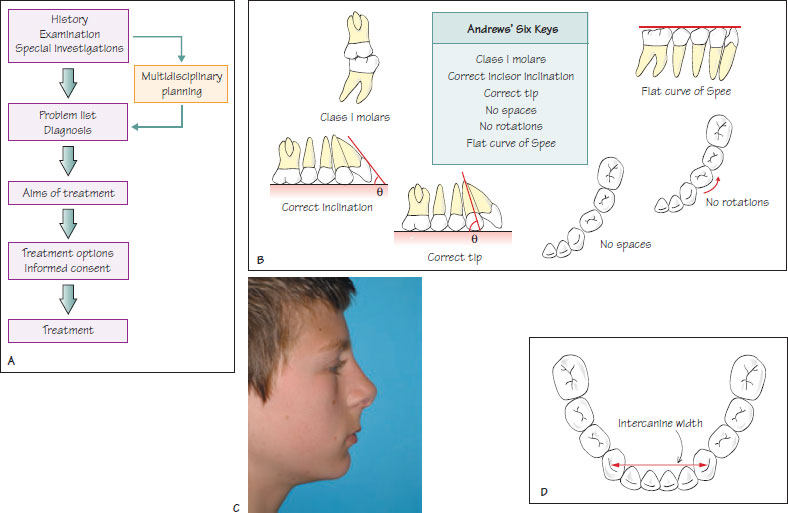11
Principles of orthodontic treatment planning
Figure 11.1 (A) The stages in orthodontic treatment planning. (B) Andrews’ six keys for ideal occlusion. (C) This patient has an increased nasolabial angle and Class II division 1 malocclusion. It may be preferable to accept an increased overjet to limit upper incisor retraction and further loss of upper lip support. (D) The lower intercanine distance should be maintained during treatment to improve stability.

Table 11.1 Factors to be considered in the extraction versus non-extraction decision.
| Factor | Comments |
| Medical history | It may be preferable to avoid extractions in patients with bleeding disorders |
| Patient preference | If a patient refuses extractions, consider other methods of space creation (e.g. headgear) |
| Compliance | Extractions maybe the only alternative if compliance with headgear is poor |
| Facial profile | Non-extraction treatment may be preferable if the lips are retrusive and the nasolabial angle is increased. Extraction treatment is preferable if the lips are too protrusive |
| Skeletal pattern | Space closure is more difficult if the vertical dimension is reduced. Extractions may be preferable if the vertical dimension is increased as they may prevent the overbite from reducing further |
| Unfavourable growth | The prospect of unfavourable growth during treatment may tip the balance towards mandibular extractions for incisor retraction in Class III cases if treatment is to be undertaken by orthodontics alone |
| Space required | A space analysis allows determination of space requirements |
| Dental health | Extraction should be considered if there are teeth with poor long-term prognosis (e.g. first permanent molars). |
| Tooth size discrepancies | Extracion treatment can help resolve tooth size discrepancies to improve occlusal fit (e.g. extraction of a lower incisor when the upper lateral incisors are microdont) |
Orthodontic treatment planning includes history taking, clinical examination and consideration of special investigations. Following this it is possible to formulate a problem list and make a diagnosis, taking into consideration aetiological factors, and establish a list of treatment aims and provide a number of treatment options (Figure 11.1A). Important treatment planning considerations are discussed below.
Risk/cost-benefit analysis
Before commencing treatment it is essential to undertake a risk/cost–benefit analysis. See C/>
Stay updated, free dental videos. Join our Telegram channel

VIDEdental - Online dental courses


